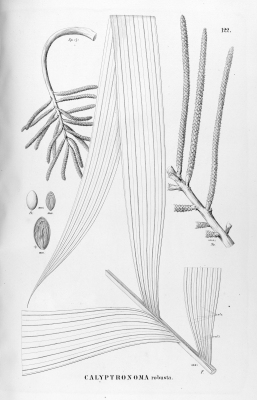Pholidostachys synanthera
(Mart.) H.E.Moore
Arecaceae
Calyptrogyne kalbreyeri Burret
Calyptrogyne robusta (Trail) Burret
Calyptrogyne synanthera (Mart.) Burret
Calyptrogyne weberbaueri Burret
Calyptronoma kalbreyeri (Burret) L.H.Bailey
Calyptronoma robusta Trail
Calyptronoma synanthera L.H.Bailey
Calyptronoma weberbaueri (Burret) L.H.Bailey
Geonoma synanthera Mart.
Common Name:

Drawing of the leaves, flowers, fruit and seed
Photograph by: Martius, C., Eichler, A.G., Urban, I., Flora Brasiliensis, vol. 3(2): fasicle 86, t. 122 (1882) [C.G.O. Drude


Drawing of the leaves, flowers, fruit and seed
Photograph by: Martius, C., Eichler, A.G., Urban, I., Flora Brasiliensis, vol. 3(2): fasicle 86, t. 122 (1882) [C.G.O. Drude


Young plant
Photograph by: Andrew J. Henderson'
Image credit to Palmweb

Fruiting stem
Photograph by: John Dransfield
Image credit to Palmweb

Inflorescence
Photograph by: John Dransfield
Image credit to Palmweb
General Information
Pholidostachys synanthera is a single-stemmed, evergreen palm growing 1.8 - 5 metres tall. The unbranched stem can be 3 - 8cm in diameter; it is topped by a crown of 10 - 25 leaves.
The plant is harvested from the wild for local use as a food and source of thatch.
Known Hazards
None known
Botanical References
768- Title
- Field Guide to the Palms of the Americas
- Publication
-
- Author
- Henderson A.; Galeano G.; Bernal R.
- Publisher
- Princeton University Press; Princeton, New Jersey.
- Year
- 1995
- ISBN
- 0-691-08537-4
- Description
- An excellent book, giving basic information on all the 550 species of palms native to the Americas that were known in 1995. Comprehensive information on the plants range and habitat, brief description, some uses and almost 250 photos.
Range
S. America - northern Brazil, Peru, Ecuador, Colombia.
Habitat
Steep slopes in premontane to montane rain forest; lowland rain forest on land not subject to periodic inundation; at elevations up to 1,500 metres[
768- Title
- Field Guide to the Palms of the Americas
- Publication
-
- Author
- Henderson A.; Galeano G.; Bernal R.
- Publisher
- Princeton University Press; Princeton, New Jersey.
- Year
- 1995
- ISBN
- 0-691-08537-4
- Description
- An excellent book, giving basic information on all the 550 species of palms native to the Americas that were known in 1995. Comprehensive information on the plants range and habitat, brief description, some uses and almost 250 photos.
].
Properties
| Edibility Rating |      |
| Other Uses Rating |      |
| Habit | Evergreen Tree |
| Height | 5.00 m |
| Cultivation Status | Wild |
Cultivation Details
Not known
Edible Uses
Leaves - cooked[
]. The apical bud, often known as a 'palm heart', is eaten as a vegetable[
]. Eating this bud leads to the death of the tree because it is unable to make side shoots[
K- Title
- Plants for a Future
- Author
- Ken Fern
- Description
- Notes from observations, tasting etc at Plants For A Future and on field trips.
].
Medicinal
None known
Other Uses
The leaves are used as thatch[
768- Title
- Field Guide to the Palms of the Americas
- Publication
-
- Author
- Henderson A.; Galeano G.; Bernal R.
- Publisher
- Princeton University Press; Princeton, New Jersey.
- Year
- 1995
- ISBN
- 0-691-08537-4
- Description
- An excellent book, giving basic information on all the 550 species of palms native to the Americas that were known in 1995. Comprehensive information on the plants range and habitat, brief description, some uses and almost 250 photos.
].
Propagation
Seed -
If you have any useful information about this plant, please leave a comment. Comments have to be approved before they are shown here.







 Useful Tropical Plants Database 2014 by
Ken Fern,
web interface by
Ajna Fern
with help from
Richard Morris.
Useful Tropical Plants Database 2014 by
Ken Fern,
web interface by
Ajna Fern
with help from
Richard Morris.